Key Competencies Kit
for Facing Lifelong Learning


 |
This Project has been funded with support from the European Commission. This communication reflects the views only of the author, and the Commission can not be held responsible for any use which may be made of the information contained therein. |
 |
Didactic Unit 4 |
Theme |
Time |
Resource management |
|
2 hours |
|
||
|
||
|
 |
 |
 |
Business resources are anything and everything that helps a company operate and do business. This can include people (human capital), natural resources, tangible resources such as property or production machinery, intangible resources such as brand image and knowledge, financial resources and anything else a particular business may use to make a profit. Every business resource used to produce goods or to serve customers has an economic value.
The most important business resource for any company is its human capital, that is, the combined skills, efforts, abilities and knowledge of people who work in your business.
Employees transform raw materials, skills and knowledge into products, or services.
Natural resources are any resource made from the natural environment such as paper, oil or minerals that a company uses to operate its business. The value of natural resources varies depending on whether it is a renewable or non-renewable resource; renewable resources will be easily replenished and reproduced naturally while non-renewable resources cannot be replaced after human consumption.
Business resources also include any tangible good that helps the company operate, such as property or rent, production machinery, supplies for final product, transportation, and overhead such as Internet and electricity. Tangible resources vary greatly across different businesses.
Important business resource is intangible resource such as brand image, goodwill or patents.
Financial resources encompass any source of revenue a company has including sales, loans, and investments.
What is resource management? It is the process of using available business resources in the most efficient way possible.
The effective management and use of business resources is an indicator of its success. Any business that efficiently uses all of its resources will make more money than businesses who do not.
Every business resource adds a certain value to the company; the value is determined by the quantity and quality of the resource. For example, the value of oil as a business resource depends greatly on quantity available while the value of human capital knowledge is about quality.
Effective resource using is impossible without setting goals that take into account available resources.
Goal setting is the process of deciding what you want to accomplish and devising a plan to achieve the result you desire.
This goal setting definition emphasizes that goal setting is a two part process. For effective goal setting, you need to do more than just decide what you want to do; you also have to work at accomplishing whatever goal you have set for yourself.
You can learn more about principles of effective goals setting from module 5 Learning to learn (didactic unit 2)
Like setting personal goals, setting business goals provides us with direction and motivation. But only if we set the right goals, goals that will keep our business on track rather than derail it.
How do we know that we're setting the right business goals? The right business goals follow basic goal setting rules.
Business goals need to be relevant.
You would think it would go without saying but lots of people set meaningless goals - and then wonder why they don't feel any sense of achievement. Remember that the purpose of goal setting is to move us forward and enhance positive change. If a goal doesn't have this motivating quality, don’t bother with it. You'll just be disappointed.
Business owners sometimes make the mistake of choosing business goals that are pointless. For instance, a business goal of a small cafe owner - to “hang out 50 announcements informing about changes in cafe menu” - is pointless. If the intention in setting this business goal was to attract more clients, it will be much better to improve quality of meals, or to reduce prices. Changing menu itself will not solve this problem. The whole exercise is just a waste of time.
To be relevant, a business goal has to possess a clear advantage or benefit to your business.
Business goals need to be specific.
An even more common mistake when setting business goals is to choose business goals that are too vague or abstract. Business goals such as – “to improve our customer service" sound nice - but if important, how are you going to do that?
When you're setting business goals, be sure that you have developed them from general statements, such as in the example above, to specific actions that can be performed and evaluated. Goals without action plans are just pretty words.
Business goals need to be achievable.
The purpose of business goals is to move our businesses forward and, to motivate us. A goal has to stretch us to be worth doing.
Commit to your goals.
You need to dedicate yourself to accomplish the goal you have chosen. That's why writing your goals down is a common goal setting tip; it's the first step to committing to achieving your goals.
Prioritize your goals.
Goals don't have to be huge projects that take months or even years to attain, but because they require commitment and need to be worked on regularly, every single goal that you set will be demanding.
Set deadlines to accomplish your goals.
A goal without a deadline is a goal that you have not fully committed to and a goal you will not achieve. Having a deadline will shape your plan of action.
Evaluate your goals.
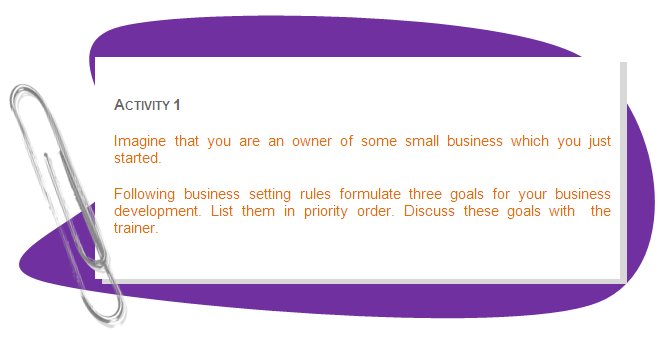

Time management is an important aspect of effective resource management.
Who hasn't wished at some point that there were more hours in a day? But we can accomplish what we want to each day if we put some basic time management principles in place and follow them.
More about time management basics you may learn from module 5 Learning to learn (didactic unit 2).
But keeping track of how you spend your time isn’t time management. Time management is about making changes to the way you spend your time. For effective time management, you have to apply a time management system that will help you see where changes can and should be made.
The time you invest in learning how to manage time will be paid back a thousand-fold.
Prioritize.
Most common mistake in business time management is thinking that that everything is equally important. It's not. For example, is meeting friends is really as important as meeting business partners? No. So if you have to choose between them, it's easy to decide to leave meeting friends for another day.
Don't just rush from task to task throughout the day. Review the list of what you have to do that day at the day's start and then pick out the things that you 'must do' that day. Then focus on getting those things done. At the end of the day, you'll have a feeling of accomplishment.
Learn to say "Yes" and "No".
The inability to say "No" is the cause of an incredible amount of misunderstanding in business. Instead of saying "No," people say "Maybe" or "I might be able to do that" or "I'll see", creating the expectation.
Make it a general rule not to say "Maybe" at all when you're asked to commit to something. Learn to make quick decisions and say "Yes" or "No" instead. And don't get hung up on elaborating. You don’t have to give extensive reasons for your decision. A simple "No, I can’t do that" is enough. The person you're speaking to will appreciate your honesty and your disinclination to waste their time.
Keeping track of your many daily activities is just a preliminary step to effective time management. The first step of time management is to analyze how you actually spend your time so you can determine what changes you want to make.
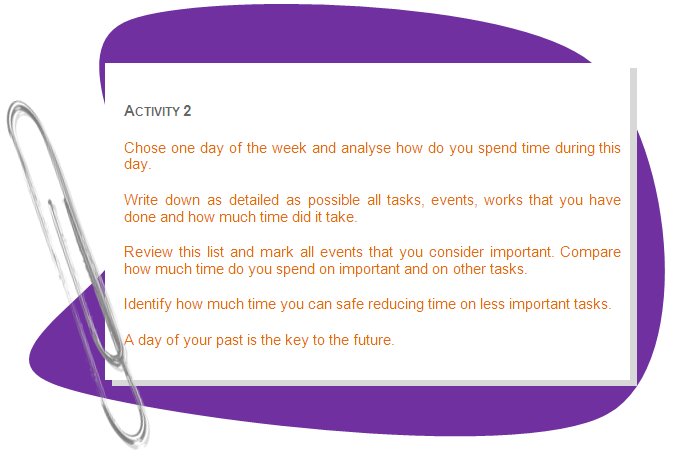

For entrepreneur understanding money management is a priority, even if you hire an accountant or bookkeeper to manage the books. You will still need to familiarize yourself with basic bookkeeping and money management principles and activities.
Once you have chosen a name and registered your business, you will need to open a commercial bank account. Setting up a business bank account is easy. Start by selecting the bank you want to work with--think small-business-friendly--and call to arrange an appointment to open an account.
There is not much more required than that. However, when you go, make sure you take personal identification as well as your business name registration papers and business license, because these are usually required to open a commercial bank account. The next step will be to deposit funds into your new account (even a small sum in good). Also be sure to ask about a credit card merchant account, debit account, and other small business services.
When it comes time to set up your financial books, you have two options--do it yourself or hire an accountant or bookkeeper. You might want to do both by keeping your own books and hiring an accountant to prepare year-end financial statements and tax forms. If you opt to keep your own books, make sure you invest in accounting software. Most accounting software programs allow you to create invoices; track bank account balances and merchant account information, and keep track of accounts payable and receivable.
If you're unsure about your bookkeeping abilities even with the aid of accounting software, you may wish to hire a bookkeeper to do your books on a monthly basis and a chartered accountant to audit the books quarterly and prepare year-end business statements and tax returns.
If you're only washing windows on weekends to earn a few extra bucks, there's little need for accounting software or accountant services. Simply invest in a basic ledger and record all business costs and sales. Since you are doing it on your own, be sure to use a commonsense approach when calculating how much to invest in your business vs. expected revenues and profits.
Another important aspect of money management is finding the money you need for your business.
There are several sources to consider when looking for financing. It is important to consider all of you options before making a decision.
It is often said that small business people have difficult time borrowing money. Banks make money by lending money. However, the inexperience of small business owners in financial matters often prompts many banks to deny loan requests. To be successful in obtaining a loan, you must be prepared and organized. You must know exactly how much money you need, why you need it and how you can pay it back.
Types of business loans Short-Term Loans: Short-term loans are paid back in less than one year. Types of short-term loans are:
|

Workers are a greatest asset of a business. Human resource management is responsible for how people are treated in businesses, with the effective use of their skills. It is responsible for bringing people into business, helping them perform their work, compensating them for their work, and solving problems that arise" .
An essential component of any human resource management, no matter the size of a business, is the job analysis, which is completed to determine activities, skills, and knowledge required of an employee for a specific job. Job analyses are performed on three occasions: (1) when the organization is first started, (2) when a new job is created, and (3) when a job is changed as a result of new methods, new procedures, or new technology.
Two important tools used in defining the job are (1) a job description, which identifies the job, provides a listing of responsibilities and duties unique to the job, and (2) the job specification, which states the minimum amount of education and experience needed for performing the job.
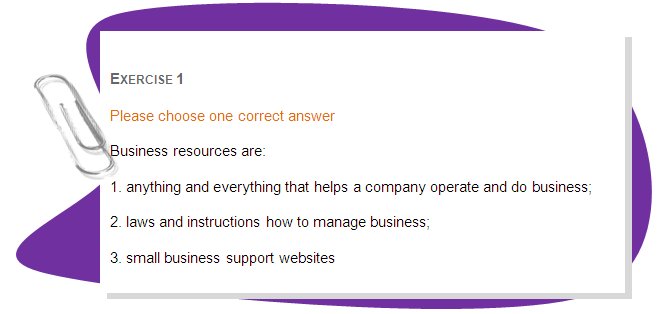
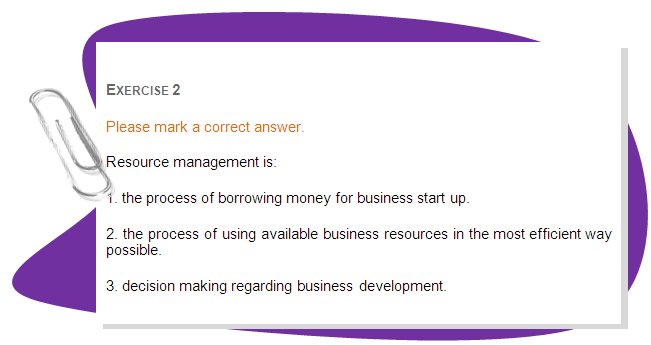
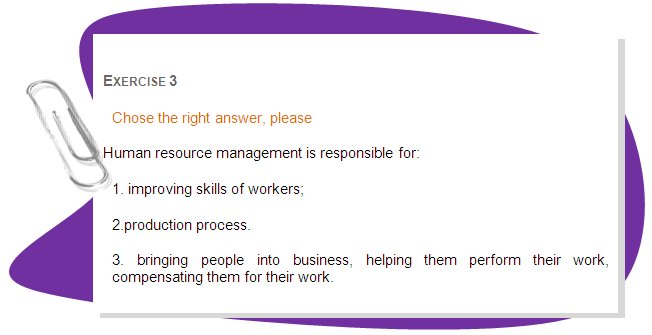
 |
Answers to the questions and exercises of Didactic Unit 4 |
1.
2.
3.